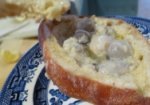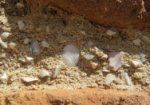This 1820s engraving is annotated:
Oysters of a delicious flavour cover the rocks about here, as well as those in every part of Port Jackson…
A place of leisure and pleasure…and oysters
Sydney Harbour was for some, a place of leisure and pleasure, providing recreational activity for the likes of Elizabeth Macarthur and Mary Anne Parker, a naval captain’s wife, who enjoyed little boating parties on the harbour. In 1791 Mrs Parker ‘feasted on oisters[sic]’ that sailors gathered and shucked on the foreshores, ‘placing them around their hats in lieu of plates, by no means diminishing the satisfaction we had in eating them.’ A novel alternative to the Styrofoam tray or a bed of rock salt, don’t you think?
A ‘peculiarly congenial’ pursuit
This type of gustatory activity was no less enjoyable some 50 years later, according to 1840s diarist Godfrey Mundy, author of Our Antipodes (1852). His reports are somewhat wordy but delightfully colourful:
There is, however, connected with the shores, and islets, and coves of the harbour, one pursuit peculiarly congenial to the tastes of the people — a pastime half jaunting, half sedentary; a little sea air, a very little personal exertion, and a large amount of gastronomic recreation; I mean, oyster-eating. Every inch of rock from Sydney to the Heads is thickly colonized by these delicate shellfish; that is, every inch would be so peopled, but for the active extermination incessantly going on. On any fine day select parties of pleasure-and-oyster-seekers may be seen proceeding by water or land, furnished with the necessary muniments for an attack, or actively engaged in it. A hammer and a chisel, an oyster-knife, a bottle of vinegar, and the pepper-pot, with a vigorous appetite, sharpened by the almost impregnable character of the foe — such are the forces brought into the field, and the inducements to distinction. It is needless to add, that the garrison are quickly shelled out of their natural stronghold.
Sadly, these days we have to satisfy ourselves with a trip to the local fishmonger or, if lucky enough, pull into a roadside vendors’ on our way up or down the coast. Oysters were an integral part of colonial Sydney life – for more than just a leisure activity, as The Curator explains in his post ‘Of oyster shells and shelly mortar’. Meanwhile, I’m reworking a now ‘lost’ oysters dish that appeared in various forms in 18th and early 19th century cookbooks – oyster loaves.
Sources:
Parker, Mary Ann (1791). A voyage around the world in the Gorgon man of war. Captain John Parker, performed and written by his widow. London : Printed by John Nichols, 1795. State Library of New South Wales
Our Antipodes, by Godfrey Charles Mundy, abbreviated and with an introduction by D.W.A. Baker. Canberra: Pandanus Books, Research School of Pacific and Asian Studies, Australian National University, 2006.



